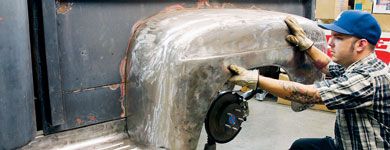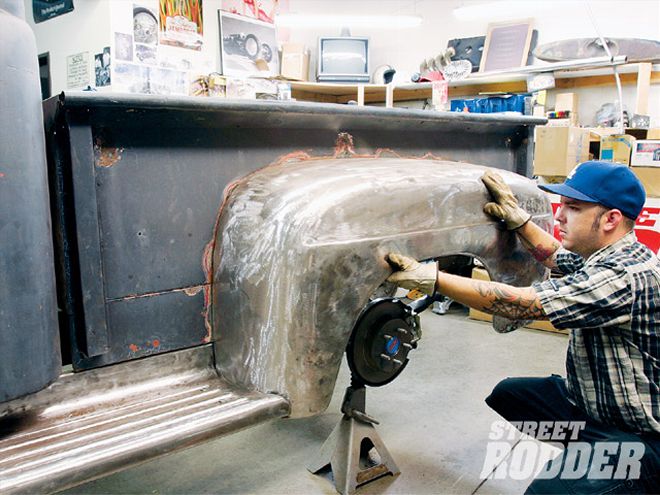

An unfortunate aspect of building a hot rod that's seen more than 50 years worth of abuse is the fact that Mother Nature, teamed up with the good ol' common man, has probably taken quite a toll on the state of the sheetmetal. Fenders littered with fist-sized dents, extra holes, skewered sides, and damaged edges. Bumpers bent, broken, or missing completely. Given the fact these old cars weren't built to last 50 years, it's no surprise to see many areas have succumbed to rust, wear, and tear. Areas where two panels meet can often function as a pocket to collect debris, dirt, and mud that eventually rusts these areas out. Wear and tear from standing on the running boards or loading and unloading items can cause the sheetmetal to rip and tear and the hardware to fail.
It shouldn't be shocking that when we started tearing into the bodywork on our '52 Ford F1 project that we would come across some sketchy areas under all those layers of old paint and body filler. The front valence under the grille had been filled, deleting the front bumper, and there were already some areas on the fenders where the body filler had cracked and was chipping away, so it was obvious somebody had performed a bit of "aftermarket" body work in the not so distant past. The only choice we had when it came time to prepping the sheetmetal for paint was to knock the existing paint and filler down and start with each piece in bare metal. This could have been accomplished by a number of means, from media blasting to acid dipping, but since either of these process' would have taken upwards of a week to complete and several hundred dollars, we decided to do it the hard way, with a 7-inch sander and a stack of 80-grit sanding discs. Later that afternoon when the dust settled, we had a fender stripped down to bare metal that was ready to get finessed back into shape.
As we mentioned before, it didn't take stripping the fenders to bare metal to know we had a few issues that would need to be dealt with. When we disassembled the truck, the areas where the running boards and fenders met on either side of the cab had succumbed to the elements to the point where they were basically rusted together. What little bit of steel that was left flaked away as the two were separated, leaving a void that would have to be replaced with a couple patch panels. On a fairly flat surface, such as the top of a fender or a door skin, replacing this void with a piece of sheetmetal cut to fit would be a simple task, but given the shape of the lower front corner of the F1's rear fenders, the patch panel that would need to be fabricated was slightly more complex. The sheetmetal fender is also beefed up in the area where it bolts up to the running board, providing a solid backing to prevent the steel from tearing under flex. Additionally, there is a lip that runs along the wheel well and rolls under the fender at the bottom, further complicating the lower fender section.
We fashioned a patch panel out of 18-gauge sheetmetal and formed it using a hammer and dolly to fit the contour of the fender. The rolled edge was accomplished by doing just that, rolling the edge of the panel over onto itself and then welding it up. The installation of the patch panel went smoother than we thought and added quite a bit of structural support in an area of the fender where it's much needed. The thicker replacement panel also provided a stout backing for the attachment of the running boards, something that was needed in the stock configuration.